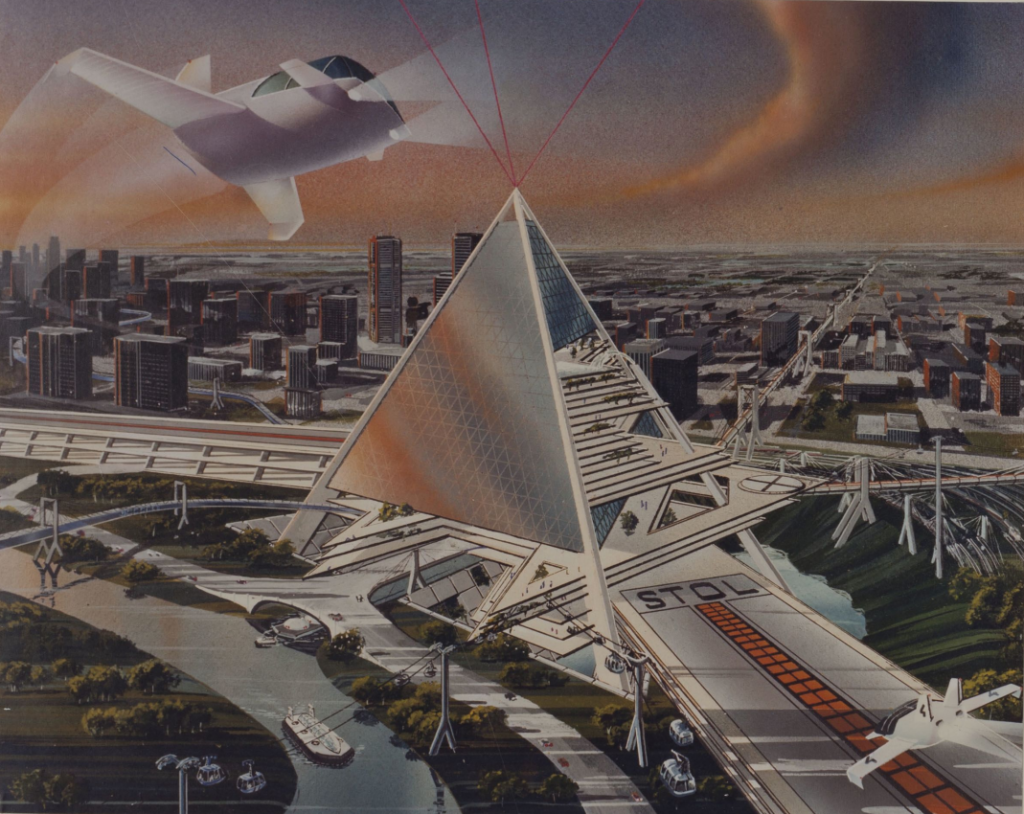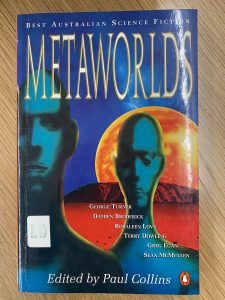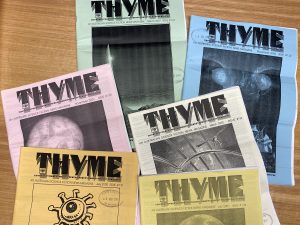
Much science fiction focuses on outward exploration of space and new worlds. In contrast, Australian science fiction writing tends to be dominated by often dystopic and post-apocalyptic settings featuring characters alienated from society. Many stories deal with anomic relationships to landscape and the environment. More recently, the voices and viewpoints of Aboriginal writers have come to the fore as a means of addressing the ongoing impacts of colonialism, racism, and inequity.
The earliest SF writing in Australia was concerned with the colonial feeling of the ‘strangeness’ of the landscape1. This relationship with landscape persists throughout much Australian SF writing, and is also illustrated in works of SF cinema such as George Miller’s Mad Max series – the titular hero journeying through the blasted desert landscapes of post-apocalyptic Australia.
The environmental concerns of dystopian fiction come to the fore in the work of authors like George Turner. The sea and the summer (1987) is a stark warning of the likely impacts of climate change on society. Another persistent theme is the lone, isolated figure alienated from society or living in a dehumanised world. Many of Peter Carey’s SF stories, for example, deal with working life inside a depersonalised capitalist society, where outsiders arbitrarily suffer on the whims of disinterested authority figures.
An emerging theme is the relationship of Aboriginality to Australian SF. While earlier works like Terry Dowling’s Rynosseros used a non-Aboriginal narrator to describe the imagined indigeneity of the far-future, more recent writers like Ambelin Kwaymullina are creating spaces for Aboriginal perspectives within the Australian SF milieu. Brian Attebury2 notes that science fiction, in this way, forms a literary ‘contact zone’ where interactions of culture – whether real or imagined – can be negotiated via fictional narratives set in envisaged futures.
The following list presents some key works, collected short fiction, graphic novels and zines held at State Library Victoria by some of the above authors and other Australian writers.
Novels

The dreaming dragons : a time opera / Damien Broderick
When Alf Dean Djanyagirnji and his nephew search for representations of the Rainbow Serpent in ancient caves, they instead find an alien vault that has implications for the origin of humanity itself. Broderick’s 1980 novel is an interesting slice of uniquely Australian science-fiction that was influential on the concept of time travel within the genre, as well as exploring Aboriginal themes. His 1982 novel The Judas Mandala famously coined the phrase “virtual reality”, presaging the cyberpunk sci-fi of the likes of William Gibson and The Matrix.
In the distant future, kite-powered ships traverse the sands of the Great Australian Desert, and technological and scientific advances have led to humanity evolving significantly, almost beyond recognition. However, there is still conflict – between mysticism and technology, the “Nationals” and the “Ab’O”, and friend and foe. In this collection of connected stories narrated from the viewpoint of an Everyman named Tom Tyson, Terry Dowling depicts a future Australia divided between cosmopolitan coastal cities and futuristic inland Aboriginal societies.
In 2034, the solar system is suddenly surrounded with an impassable barrier that causes the stars and wider universe to disappear from view. Thirty years later, in the Republic of Hong Kong, a detective investigates the disappearance of a young woman with a secret power and discovers there is more to the case than meets the eye. Combining noir-ish detective/thriller elements with the Copenhagen interpretation of quantum physics, Greg Egan takes the implications of neural modifications and artificial intelligence hinted at in the works of William Gibson to a whole new level.
The interrogation of Ashala Wolf / Ambelin Kwaymullina
A dystopian story set three hundred years into the future, Ashala Wolf is the leader of a group of young outcasts trying to survive under a new regime. However, when she is captured and interrogated by the Chief Administrator, Ashala risks losing the Tribe she has fought so hard to preserve. The first in the Tribe series by Palyku novelist, illustrator, and assistant professor of law Ambelin Kwaymullina.
Tomorrow, when the war began / John Marsden
A group of teenagers return from a camping holiday only to find their families and friends gone. What follows is a tense and action-packed narrative about survival and courage, that also realistically captures how teenagers might adapt to these extreme circumstances. Less fantastical sci-fi than a chilling speculative narrative about a military invasion of Australia, this is the first of a seven novel series by Marsden.
Souls in the great machine / Sean McMullen
Two thousand years into the future, there is no electricity – wind engines power trains and human slaves power computers. Society is controlled by secretive Librarians who settle disputes by duel. But the world is on the brink of a new ice age, and a mysterious ‘call’ hypnotises all who hear it. The first volume of Sean McMullen’s epic steampunk Greatwinter trilogy.
British expat Nevil Shute’s 1957 post-apocalyptic novel On the Beach captures the tenor of Cold War paranoia about nuclear war. Set initially in Melbourne, this incredibly bleak story imagines a world in the nuclear aftermath of World War 3. It was later turned into a feature film in 1959 with Gregory Peck, Ava Gardner, Fred Astaire and Tony Perkins.
Collected fiction
The best Australian science fiction writing : a fifty year collection / edited by Rob Gerrand This volume highlights a range of Australian SF authors and styles over a 50-year period – from early pioneers such as A. Bertram Chandler and Frank Byrning, through to more recent works by Margo Lanagan and Lucy Sussex.

Metaworlds / edited by Paul Collins
Many of the stories collected here feature Australian settings and themes, such as ‘I still call Australia home’ by George Turner, almost an Antipodean spin on Walter M. Miller Jr’s A canticle for Leibowitz. Rosaleen Love’s ironic The total devotion machine shows the influence of feminism on SF writing in the 1980’s and 1990’s.
More Australian SF collected here with many previously unpublished stories from authors including George Turner, Damien Broderick, Lucy Sussex, Paul Collins and Kurt von Trojan.
Graphic novels and zines

Mr Unpronounceable Adventures / Tim Molloy
The eldritch, gruesome, incomprehensible, paradoxical, and uproarious exploits of Mr. Unpronounceable are collected in this volume by Melbourne writer and artist Tim Molloy.
Aurealis : the Australian magazine of fantasy and science fiction
This long-running SF and fantasy writing magazine forms a veritable who’s-who of Australian SF, with works by Terry Dowling, Damien Broderick, and Greg Egan, among others.

Thyme : the Australian Science Fiction news magazine
This Melbourne-based SF magazine ran between 1981 and 2003, featuring SF news, reviews, and interviews with a focus on Australian SF. The library has a nearly complete run available to request from onsite storage.
References
- Blackford, R, McMullen, S, & Ikin, V, 1999, Strange constellations: a history of Australian science fiction, Greenwood Press, Westport, Conn
- Attebery, B, 2005, ‘Aboriginality in science fiction’, Science fiction studies, Vol 32, no 3, pp 385–404


That Mad Max clip is GOLD!